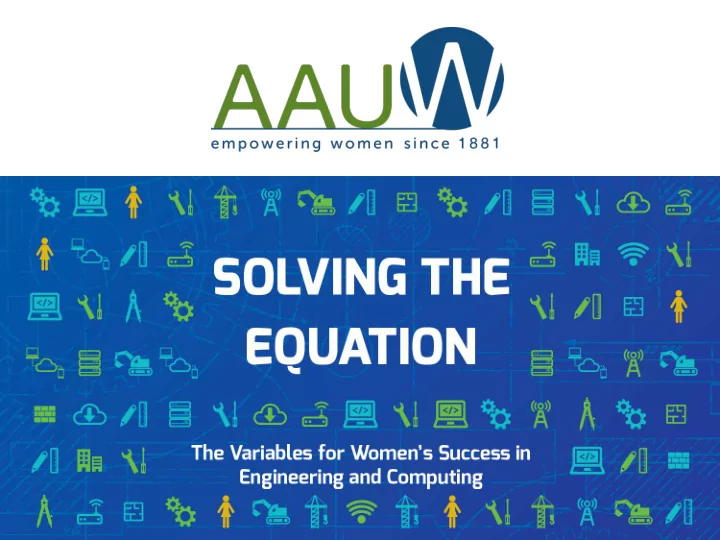

Solving the Equation The Variables for Women’s Success in Engineering and Computing
U.S. population ages 20- 24 and engineering bachelor’s degrees awarded, by race / ethnicity and gender, 2013 Note: Underrepresented minority (URM) includes American Indians and Alaska Natives, blacks, and Hispanics / Latinos Source: L.M. Frehill analysis of NSF NCSES (2014) and U.S. Census Bureau, 2014
Stereotypes and Biases
Source: Smyth, Greenwald et al. (2015). Adapted with permission from Frederick L. Smyth
What can we do? • Create environments that are welcoming for girls and women • Find positive role models • Raise awareness about implicit gender-science bias • Take test at implicit.harvard.edu
Making the World a Better Place
Sense of Belonging
What can we do? • Provide early opportunities to do real-world engineering work • Emphasize the social relevance of engineering • Frame adversity as a common experience for everyone
What can colleges do? • Revise their introductory courses and split them into levels divided by experience • Provide research opportunities for undergraduates after their first year in college • Take female students to the Grace Hopper Celebration of Women in Computing or similar conferences
Engineering Bachelor's Degrees Awarded to Women by U.S. Engineering Schools with the Highest Representation of Women, 2012 Percent Rank Institution Female Total women Smith College 1 22 22 100% Prairie View A & M University 2 69 105 66% 3 Harvard University 28 60 47% 4 Massachusetts Institute of Technology 201 453 44% California Institute of Technology 5 44 101 44% 6 Howard University 24 56 43% 7 George Washington University 40 94 43% Tuskegee University 8 18 43 42% Franklin W. Olin College of 9 Engineering 28 69 41% Rice University 10 83 215 39% 11 Harvey Mudd College 25 65 38% 12 Stanford University 125 335 37% Humboldt State University 13 13 35 37% Princeton University 14 64 177 36% 15 Yale University 24 67 36% Tulane University of Louisiana 16 16 45 36% Northwestern University 17 108 305 35% 18 University of Pennsylvania 100 286 35% 19 University of Alaska Anchorage 20 58 34% Hope College 20 11 32 34% 21 Cornell University 196 577 34% 22 Tufts University 65 192 34% North Carolina A & T State University 23 61 183 33% Eastern Michigan University 24 15 45 33% 25 University of Puerto Rico Mayaguez 193 580 33% Note: Table includes only those institutions that conferred at least 20 engineering bachelor’s degrees in 2012. Frehill, L.M. (2014). Analysis of National Science Foundation, National Center for Science and Engineering Statistics, Integrated Postsecondary Education Data System (IPEDS) Completions Survey, 2013, Integrated Science and Engineering Resources Data System (WebCASPAR) (https://webcaspar.nsf.gov) [access date 29 April 2014].
www.aauw.org/research/solving-the-equation My email: corbettc@aauw.org
Recommend
More recommend